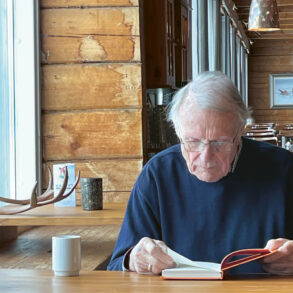Waldorf education is not a program that is set in stone. No matter how many critics claim that Waldorf education is based on a dogmatic structure that is unscientific and outdated, this is not the case: it needs the individual and their ability to empathize.
What exactly is Waldorf education? In August 1923 in England, Rudolf Steiner gave a succinct answer to this question asked repeatedly by parents, teachers, and journalists. Waldorf education, he said, “is purely and simply a matter of practice, and one can only give examples of a practical way of dealing with the needs of particular cases.”1 In 1923, at the International Christmas Course for Teachers in the newly completed first Goetheanum, Rudolf Steiner spoke about teachers who worked in parallel classes at the Stuttgart Waldorf School and were studying and sharing completely different materials. Steiner said that this generally applied to all teachers at the Waldorf School: “One could even say that teachers are free to approach subjects in their own individual ways since, in any event, they must prepare their subject material according to what they have learned from life.”2 What is essential for Steiner is, first and foremost, the educator, the teacher: their powers of observation, relationship skills, imagination and intuition, which ensure that “in this or that case” a meaningful pedagogical act has come about.
Steiner had expressed this even more clearly a year earlier, in Oxford, in August 1922. Based on the difference between a machine and a living organism (a machine can be programmed, but a living being must first be accepted as it is), Steiner said: “In this sense, a school such as the Waldorf school is an organism from the outset and cannot be organised by drawing up a programme—as I have already indicated—as to how the school should be organised: Paragraph 1, Paragraph 2 and so on.”3 Anyone who founds a school and only implements a program that has been devised in advance is basically not respecting the teachers, parents and children who have come together in this school enterprise. They are not made of wax that can be moulded at will. What is very important for the development of the school is that the teachers and carers get to know each other thoroughly, that they get to know and understand the children and parents.
No matter how many educationalists criticise certain Waldorf institutions for having a colonial attitude, this attitude cannot be inferred from Steiner’s initial statements. Rather, he urges us to be sensitive to the context: first, get to know the circumstances and the people, and then see which particular form of school and pedagogy would like to appear in a certain place at a particular time. “It is not a question of having theoretical principles and rules, but of meeting reality as it comes.”4
Feelings Are What Is Most Important
These two characteristics of Waldorf education—the teacher with his or her power of inspiration and initiative, and the endeavour to get to know their colleagues, the children, and the parents better and better—serve to honour and accept the special living conditions in which human culture is always embedded, its beauty but also its limitations. A third quality is the heartfelt invitation to the people involved not to simply leave their emotional life as it is but to deepen it and turn towards an unfathomable theme: “What really matters in education are the mood and soul attitude that teachers carry in their hearts toward the human being.”5 The most important thing is the feelings!
This is something intangible and very individual, and yet it no longer remains centred on our personal situation but turns towards the study of child development and psychology; in other words, the study of human nature. It involves descriptions of the human being in all its dimensions, the visible and the invisible, precise descriptions of how the relationships between body, soul, and spirit change in children and adolescents over the years, how will and feeling develop, what qualities the child brings with it from prenatal dimensions, and how the healthy development of body-bound senses metamorphoses over the years into mental habits.
Steiner provides plentiful indications and shakes up our habits of thought, “bringing into flow our firmly established concepts,” but not as an ideology or programme, as he has clearly stated before. Rather, it is as a contribution to the study of the nature of the human being that works on feelings. Thus, not as thoughts that are to be believed but as thoughts that first need to be understood and to which one’s feelings are “exposed.”
After going through the personal emotional world and getting to know the children and parents, what emerges as concrete, creative educational activity is completely open. It will come as a surprise—a seed from the study of human nature that takes root in my emotional world, is then forgotten for a while and suddenly, in a very special situation, in an encounter with certain children and young people, or parents and colleagues, surprising flowers and fruits suddenly sprout. “Let the individual teacher arrange things as he will, if he only brings with him that which is deposited in his heart through a correct insight into human nature, he will be able to do the right thing in one way and in another.”6
Individualize!
How can such a sentence be understood when one remembers that Rudolf Steiner himself made many curriculum proposals, which Caroline von Heydebrand, Ernst A. Stockmeyer, Tobias Richter and, for instance, a group of experts at the Federation of German Waldorf schools have further elaborated and updated?7 There have also been several authors who have presented curricula for schools in English-speaking countries and, most recently, a version that can be accessed via an app and website.8 In many countries, Waldorf national associations have presented specific Waldorf curricula that are tailored to their cultural area, correspond to the respective national standards, and, in some cases, are officially recognised by the ministries of education.
The wealth of experience and the fruits of endless pedagogical creativity of many generations of Waldorf teachers are now available for today’s young professionals to build on. They can become experts much more quickly, compare different curriculum proposals with each other and see the possible differences and similarities with state curricula.
But no matter how rich the curricula’s wealth of experience may be—if I have no understanding of child development and psychology, of anthropology and the laws of human development, if I do not connect my feelings with these questions and meet the children entrusted to me full of wonder and enthusiasm so that they feel seen by me, if I do not individualise my educational practice according to my own characteristics and those of the children—then I am still missing the very thing that the initiator of Waldorf education found so important for education: “That something is deposited in our hearts through a correct insight into human nature.”9
Translation Joshua Kelberman
Photo Xue Li
Footnotes
- Rudolf Steiner, A Modern Art of Education, CW 307 (Great Barrington, MA: Anthroposophic Press, 2004), lecture in Ilkey on Aug. 10, 1923.
- Rudolf Steiner, Soul Economy: Body, Soul, and Spirit in Waldorf Education, CW 303 (Great Barrington, MA: Anthroposophic Press, 2003), lecture in Dornach on Dec. 29, 1921.
- Rudolf Steiner, The Spiritual Ground of Education, CW 305 (Great Barrington, MA: Anthroposophic Press, 2004), lecture in Oxford, England, on Aug. 23, 1922.
- Ibid.
- Rudolf Steiner, Soul Economy: Body, Soul, and Spirit in Waldorf Education, CW 303 (Great Barrington, MA: Anthroposophic Press, 2003), lecture in Dornach on Dec. 29, 1921.
- Ibid.
- “Der Lehrplan der freiein Waldorfschulen” [The Curriculum of the Independent Waldorf Schools], Pädagogische Forschungsstelle [Pedagogical Research Center.
- Kate Bransby and Martyn Rawson, “Rethinking and Redesigning Waldorf Curricula,” Art of Educating (July 2023).
- Rudolf Steiner, Soul Economy: Body, Soul, and Spirit in Waldorf Education, CW 303 (Great Barrington, MA: Anthroposophic Press, 2003), lecture in Dornach on Dec. 29, 1921.









